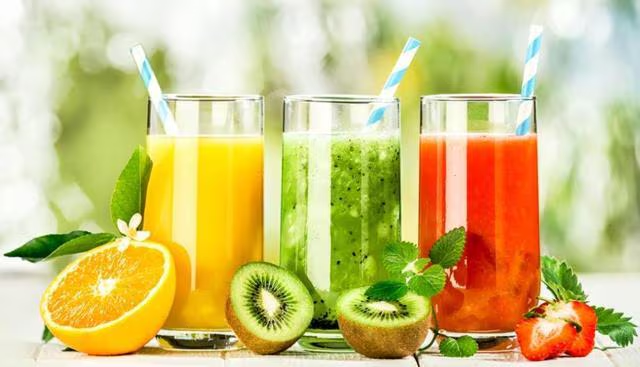In today’s fast-paced world, where health and fitness are paramount, finding delicious yet nutritious ways to shed those extra pounds is a top priority. One approach that has gained immense popularity is incorporating healthy fruit juice cocktails into your diet. These vibrant concoctions are not only a treat for your taste buds but also pack a punch in terms of aiding weight loss. Let’s dive into the world of fruity delights and discover how these wholesome beverages can help you achieve your fitness goals.
1. The Power of Fresh Ingredients
Juicing for Weight Loss
When it comes to juicing for weight loss, the cornerstone of success lies in the quality of your ingredients. The journey to shedding those extra pounds begins with choosing the freshest and most nutritious fruits and vegetables for your homemade juices.
Why Freshness Matters
Nutrient Density:- Fresh fruits and vegetables are bursting with essential nutrients, including vitamins, minerals, and antioxidants. These nutrients play a vital role in supporting your overall health and well-being while aiding in weight loss.
Low in Calories:- Most fresh produce is naturally low in calories, making it an ideal choice for those aiming to shed pounds. You can enjoy the flavours without worrying about excessive calorie intake.
Hydration:- Many fruits and vegetables have high water content, which not only keeps you hydrated but also contributes to a feeling of fullness, reducing the likelihood of overeating.
Fibre Content:- Fresh ingredients are a rich source of dietary fibre, which is crucial for digestive health and appetite control. Fibre helps you stay satiated for longer, curbing those midday cravings.
Selecting Fresh Produce
When shopping for ingredients for your weight-loss juices, keep these tips in mind:
Farmers’ Markets: Visit local farmers’ markets for the freshest seasonal produce. These fruits and vegetables are often harvested at their peak ripeness, ensuring maximum flavour and nutritional value.
Organic Options: If possible, opt for organic produce to minimize exposure to pesticides and chemicals. Organic fruits and vegetables tend to be of higher quality and may offer additional health benefits.
In-Season Choices: Choose fruits and vegetables that are in season. They are more likely to be fresh, affordable, and packed with flavour.
Inspect Carefully: Examine the produce carefully for any signs of wilting, bruising, or mould. Fresh ingredients should be firm, vibrant, and free from blemishes.
Juicing Techniques
To make the most of your fresh ingredients, follow these juicing techniques:
Wash Thoroughly: Rinse your fruits and vegetables under cold running water to remove dirt and any potential contaminants.
Peel When Necessary: Some fruits and vegetables, like oranges and carrots, may need to be peeled to remove any bitter or tough outer layers.
Remove Seeds: Take out seeds and pits from fruits like apples and peaches before juicing.
Variety is Key: Experiment with different combinations of fresh ingredients to create a variety of flavours and maximize nutritional benefits.
In conclusion, the power of fresh ingredients in your weight loss journey cannot be overstated. When you start with the finest produce nature has to offer, you’re not only ensuring the deliciousness of your juices but also taking a significant step toward achieving your fitness goals. So, embrace the vibrancy of fresh fruits and vegetables, and let them be your partners on the path to a healthier you.
2. Balancing Act
Creating a Nutrient-Rich Blend
In the fast-paced world we live in today, maintaining a healthy lifestyle can be quite the balancing act. Our bodies require a wide range of nutrients to function at their best, and finding ways to incorporate these essential elements into our diets can sometimes be a daunting task. However, fear not! In this comprehensive guide, we’ll explore the art of creating a nutrient-rich blend that not only tastes delicious but also provides your body with the nourishment it craves.
The Importance of a Balanced Diet
Before we dive into the specifics of crafting a nutrient-rich blend, it’s crucial to understand why a balanced diet matters. Your body is like a well-oiled machine, and each nutrient plays a unique role in keeping it running smoothly.
Fuel for Energy
Carbohydrates, found in foods like grains and fruits, serve as your body’s primary source of energy. When you consume carbohydrates, your body converts them into glucose, providing the fuel needed for everyday activities.
Building Blocks
Proteins are the building blocks of life. They help repair and grow tissues, produce enzymes, and support various bodily functions. Sources of protein include lean meats, dairy, and legumes.
Essential Fats
Fat often gets a bad rap, but it’s an essential part of a healthy diet. Fats help your body absorb vitamins, protect your organs, and maintain cell health. Opt for sources of healthy fats like avocados, nuts, and olive oil.
Vitamins and Minerals
Vitamins and minerals are micronutrients that your body needs in small quantities. They are involved in a wide array of processes, from bone health to immune function. Fruits, vegetables, and whole grains are excellent sources of these vital nutrients.
Now that we’ve covered the basics, let’s explore how you can create a nutrient-rich blend that incorporates all these essential components.
The Art of Blending
Choose a Base
Every great blend starts with a base. When it comes to nutrient-rich blends, you have several options:
Leafy Greens: Spinach, kale, and Swiss chard are excellent choices. They are packed with vitamins and minerals, including iron and calcium.
Fruits: Berries, bananas, and oranges add natural sweetness and a dose of vitamins to your blend.
Greek Yogurt: For a creamy texture and added protein, consider adding a scoop of Greek yoghurt.
Mix in Proteins
Proteins are essential for muscle repair and overall health. You can include them in your blend by adding:
Protein Powder: Opt for a high-quality protein powder that aligns with your dietary preferences, such as whey, plant-based, or collagen.
Nut Butter: A tablespoon of almond or peanut butter not only adds creaminess but also a protein punch.
Healthy Fats for Satiety
Don’t forget to incorporate healthy fats to keep you feeling full and satisfied:
Avocado: It lends a velvety texture and is a source of heart-healthy monounsaturated fats.
Chia Seeds: These tiny seeds are packed with omega-3 fatty acids and fibre.
Boost with Superfoods
Superfoods are nutrient powerhouses that can elevate your blend’s nutritional value:
Spirulina: This blue-green algae is rich in protein, vitamins, and antioxidants.
Flaxseeds: They are a great source of fibre, omega-3 fatty acids, and lignans.
Liquid Love
To achieve the perfect consistency, you’ll need a liquid component:
Water: The simplest choice, but you can also use coconut water or herbal tea for added flavour.
Milk: Dairy or plant-based milk like almond, soy, or oat milk.
Putting It All Together
Now that you have all your ingredients ready, it’s time to create your nutrient-rich blend. Simply add your chosen base, proteins, healthy fats, superfoods, and liquid to a blender. Blend until smooth and creamy. You can customize the proportions to suit your taste and dietary requirements.
3. Say No to Added Sugar
Natural Sweeteners
In the pursuit of a healthier lifestyle, one of the most impactful choices you can make is reducing or eliminating added sugar from your diet. The excessive consumption of added sugar has been linked to various health issues, including obesity, diabetes, heart disease, and dental problems. Instead of relying on refined sugars, consider embracing the goodness of natural sweeteners.
The Harmful Effects of Added Sugar
- Empty Calories: Added sugar provides empty calories, offering little to no nutritional value. These extra calories can lead to weight gain and an increased risk of obesity.
- Blood Sugar Spikes: Consuming sugary foods and drinks can cause rapid spikes in blood sugar levels, leading to energy crashes and mood swings.
- Dental Decay: Sugar is a primary culprit behind tooth decay and cavities. Bacteria in the mouth feed on sugar, producing acids that harm tooth enamel.
- Increased Risk of Chronic Diseases: A diet high in added sugar is associated with a higher risk of chronic diseases, including type 2 diabetes, heart disease, and certain cancers.
Choosing Natural Sweeteners
Natural sweeteners are a healthier alternative to added sugars because they are minimally processed and retain some beneficial nutrients. Here are some natural sweeteners to consider:
- Honey: Honey is a natural sweetener that not only adds sweetness but also offers antioxidants and antibacterial properties. Opt for raw, unprocessed honey for maximum health benefits.
- Maple Syrup: Maple syrup is rich in antioxidants and provides essential minerals like zinc and manganese. It has a unique flavour that enhances a variety of dishes.
- Stevia: Derived from the leaves of the stevia plant, stevia is a calorie-free natural sweetener that doesn’t impact blood sugar levels. It’s an excellent choice for those looking to reduce calorie intake.
- Date Paste: Made from pureed dates, date paste is a naturally sweet and fibre-rich alternative. It can be used in baking and as a topping for various foods.
- Molasses: Blackstrap molasses, in particular, is a nutritious sweetener containing iron, calcium, and magnesium. It has a robust flavour that works well in certain recipes.
Making the Switch
To transition away from added sugar and embrace natural sweeteners:
- Read Labels: Check food labels for hidden sugars, which can be listed under various names like sucrose, high fructose corn syrup, or cane sugar.
- Experiment: Try different natural sweeteners to find the ones you enjoy the most and that suit your culinary needs.
- Moderation: While natural sweeteners are healthier, they should still be used in moderation as part of a balanced diet.
- Homemade Treats: Consider making your snacks and treats using natural sweeteners, giving you full control over your sugar intake.
By saying no to added sugar and opting for natural sweeteners, you can satisfy your sweet tooth while supporting your overall health and well-being. It’s a simple yet powerful step towards a healthier lifestyle.
4. Portion Control Matters
Sip Mindfully
When it comes to managing your diet and overall well-being, portion control is a fundamental aspect that often goes overlooked. Additionally, incorporating the practice of mindful sipping can make a significant difference in your quest for a healthier lifestyle.
The Importance of Portion Control
Calorie Management: Controlling portion sizes helps manage calorie intake. Consuming large portions, even healthy foods, can lead to excessive calorie consumption, which may contribute to weight gain.
Satisfaction: Eating smaller, well-balanced portions can help you feel more satisfied after a meal. This can prevent overeating and the discomfort associated with it.
Blood Sugar Control: Portion control is especially crucial for individuals with diabetes. Eating consistent portion sizes can help regulate blood sugar levels and prevent spikes and crashes.
Digestive Health: Eating appropriate portion sizes supports healthy digestion. Overeating can lead to indigestion, bloating, and discomfort.
Practical Tips for Portion Control
Use Smaller Plates: Opt for smaller plates and bowls to create the illusion of a full meal with smaller portions.
Measure Ingredients: When cooking or preparing meals, use measuring cups and kitchen scales to accurately portion your food.
Mindful Eating: Pay attention to hunger cues and stop eating when you feel satisfied, not overly full.
Avoid Distractions: Eat without distractions like TV or smartphones. Focusing on your meal helps you recognize when you’re full.
Share Meals: When dining out, consider sharing dishes with a friend to reduce portion sizes.
Sip Mindfully for Better Hydration
Mindful sipping goes beyond just portion control; it applies to beverages as well. Whether you’re drinking water, tea, or other beverages, mindful sipping can enhance your hydration experience.
Enjoy Each Sip: When you take a drink, savour the flavour and be present at the moment. Appreciate the act of nourishing your body with hydration.
Stay Hydrated Throughout the Day: Consistent sips of water can help you stay hydrated without overloading your stomach.
Limit Sugary Drinks: Be mindful of sugary beverages, as they can add unnecessary calories and sugar to your diet.
Listen to Thirst: Pay attention to your body’s signals. Drink when you’re thirsty and stop when you’re satisfied.
5. Spice It Up
Flavorful Additions
When it comes to elevating the taste and appeal of your dishes, nothing quite matches the magic of spices and flavorful additions. These culinary treasures not only tantalize your taste buds but also bring a range of health benefits and creative possibilities to your cooking.
The Art of Spicing It Up
Cinnamon: This aromatic spice adds warmth and sweetness to both sweet and savoury dishes. Sprinkle it on oatmeal, yoghurt, or roasted vegetables for a delightful twist.
Ginger: Fresh or ground ginger adds zing and a hint of spiciness to dishes. It’s an excellent choice for stir-fries, soups, and even homemade ginger tea.
Turmeric: Known for its vibrant golden colour, turmeric boasts anti-inflammatory properties. It’s a staple in curry dishes and can be used to add a healthy dose of flavour and colour to rice, soups, and roasted vegetables.
Garlic: Fresh garlic or garlic powder can transform any dish. It’s a versatile addition to sauces, marinades, and sautéed vegetables.
Chili Peppers: For those who enjoy a bit of heat, chilli peppers or red pepper flakes can be sprinkled on pasta, pizza, or Mexican-inspired dishes.
Flavorful Additions to Elevate Your Meals
Fresh Herbs: Fresh herbs like basil, cilantro, mint, and parsley infuse your dishes with vibrant, aromatic flavours. Use them as garnishes or mix them into salads and sauces.
Citrus Zest: Grated citrus zest (lemon, lime, or orange) adds brightness and complexity to your meals. It’s a fantastic addition to marinades, dressings, and desserts.
Nuts and Seeds: Toasted nuts and seeds such as almonds, sesame seeds, and pine nuts provide a delightful crunch and nutty flavour to salads and main courses.
Coconut: Coconut flakes or coconut milk can transform a dish into a tropical delight. Use it in curries, smoothies, or as a topping for desserts.
Balsamic Vinegar: A drizzle of balsamic vinegar enhances the flavour of roasted vegetables, grilled meats, and even strawberries for a sweet and tangy twist.
Conclusion: Your Path to a Healthier You-
- In each of these aspects, you’ve discovered that your choices matter. Your daily decisions about what you eat and how you eat play a vital role in shaping your journey towards a healthier you.
- Remember, this path is not about deprivation or extreme measures. It’s about making conscious choices, finding joy in nourishing your body, and celebrating the flavours of wholesome ingredients. It’s about respecting your body’s signals and listening to what it needs.
- As you move forward on this path, continue to explore, learn, and adapt. Seek balance in your choices, and don’t forget to savour the deliciousness of every step. Your journey towards a healthier you is not a destination; it’s a continuous, enriching experience.
- So, raise your glass to a future filled with vitality, well-being, and the simple pleasure of good food. Here’s to your path to a healthier you, where every choice is a step towards a brighter, more vibrant life.















